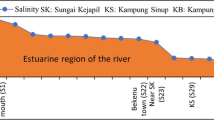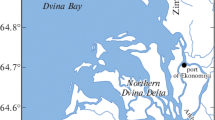Abstract
Water samples were collected for 23 different stations along a cross section profile of an estuary extending over to adjacent sea. The collected water samples were filtered and analyzed for major–minor ions and strontium isotope using the standard procedure to understand the geochemical behaviors of major and minor elements. The normalized values indicated that all riverine elements were entering to adjacent coastal sea with some significant variations at the estuary. The seawater dilution and regression lines explain about the overall patterns for seven elements. Removal processes were detected on calcium, magnesium, strontium and sulfate in the estuarine region. No significant mineral precipitation observed to release magnesium with respect to calcium. Minor variations of strontium and sulfate ions could be attributed to the presence of organic matter in the study area. Comparing seven elements with total suspended matters revealed that the total suspended matters played crucial role in either adsorption or absorption of all the elements in estuary before it reaches to coastal sea. Mixing patterns of strontium isotope showed minimal non-conservative with an evidence of active geochemical process in the estuary.



Similar content being viewed by others
References
Andersson PS, Wasserburg GJ, Ingri J (1992) The sources and transport of Sr and Nd isotopes in the Baltic Sea. Earth Planet Sci Lett 113:459–472
Bell RG (1994) Behavior of dissolved silica, and estuarine coastal mixing and exchange process at Tairua Harbour, New Zealand. N Z J Mar Fresh 28:55–68
Brich GF, Evenden D, Teutsch ME (1996) Dominance of point source heavy metal distributions in sediments of major Sydney estuary (Australia). Environ Geol 28:169–174
Brunskill GJ, Zagorskis I, Pfitzher J (2003) Geochemical mass balance for lithium; boron; and strontium in the Gulf of Papus; Papua New Guinea (Project TROPICS). Geochim Cosmochim Ac 67:3365–3383
Charette MA, Sholkovitz ER (2006) Trace element cycling in a subterranean estuary Part 2. Geochemistry of the pore water. Geochim Cosmochim Ac 70:811–826
Chen JS, Wang FY, Xia XH, Zhang LT (2002) Major element chemistry of the Changjiang (Yangtze River). Chem Geol 187:231–255
Ding T, Wang D, Wang C, Zhang F (2004) Silicon isotope composition of dissolved silicon and suspended matters in the Yangtze River, China. Geochim Cosmochim Ac 68:205–216
Hu H, Hu F (1995) Water types and frontal surface in the Changjiang estuary. J Fish Sci China 2:81–90 (In Chinese)
Hu MH, Stallard RF, Edmond JM (1982) Major ion chemistry of some large Chinese rivers. Nature 298:550–553
Hunter KA (1983) On the estuarine mixing of dissolved substances in relation to colloid stability and surface properties. Geochim Cosmochim Ac 47:467–473
Ingram BL, DePaolo DJ (1993) A 4300-year strontium isotope record of estuarine paleosalinity in San Franciso Bay, California. Earth Planet Sci Lett 119:103–119
Ingram BL, Sloan D (1992) Strontium isotopic composition of estuarine sediments as paleosalinity-paleoclimate indicator. Science 255:68–72
Jiang G, Yao Y, Tang Z (2002) The analysis for influencing factor of fine sediment flocculation in the Changjiang estuary. Acta Oceanol Sin 24:51–57 (in Chinese with English abstract)
Knudsen M (1902) Berichteüber die Konstantenbestimmung zur Aufstellung hydrographischen Tabellen. Kgl Dan Vidensk Selsk Skr Naturvidensk 12:1–151
Li JY, Zhang J (2003) Variations of solid content and water chemistry at Nantong station and weathering processes of the Changjiang watershed. Resour Environ Yangtze Basin 12:363–369 (in Chinese with English abstract)
Li D, Li J, Chen J, Chen X, Chen B (2000a) A study on suspended matter in the Changjiang river estuary. Oceanol Limnol Sin 31:295–301 (in Chinese with English abstract)
Li J, He Q, Zhang C (2000b) A study on sediment deposition and resuspension in the Mouth Bar area of the Changjiang river estuary. Oceanol Limnol Sin 31(1):101–109 (in Chinese with English abstract)
Lisitsyn AP (1995) The marginal filter of the ocean. Oceanology 34:671–682
Mook WG, Koene BKS (1975) Chemistry of dissolved inorganic carbon in estuarine and coastal brackish waters. Estuar Coast Mar Sci 3:325–336
Ramanathan AL, Vaithiyanathan P, Suberamanian V, Das BK (1993) Geochemistry of the Cauvery estuary; East Coast of India. Estuaries 16:459–474
Ray SB, Mohanti M, Somayajulu BLK (1984) Suspended matter; major cations and dissolved silicon in the estuarine water of the Mahanadi River, India. J Hydrol 69:183–196
Schijf J (2007) Alkali elements (Na; K; Rb) and alkaline earth elements (Mg; Ca; Sr; Ba) in the anoxic brine of Orca Basin; north Gulf of Mexico. Chem Geol 243:255–274
Schijf J, Byrne RH (2007) Progressive dolomitization of florida limestone recorded by alkaline earth element concentrations in saline; geothermal; submarine springs. J Geo Res 12:C01003. doi:10.1029/2006JC003659
Sharma M, Balakrishna K, Hofmann AW, Shankar R (2007) The transport of osmium and strontium isotopes through a tropical estuary. Geochim Cosmochim Ac 71:4856–4867
Shi Z, Ling H (1999) Vertical profiles of fine suspension concentration in the Changjiang estuary. J Sed Res 2:59–64 (in Chinese with English abstract)
Subramanian V, Jha PK (1988) Geochemical studies on Hoogly estuary. Mitt Geol Palen Inst Scope/UNEP Sonderband, Hamburg, pp 267–288
Wang ZL, Liu CQ (2003) Distribution and partition behavior of heavy metals between dissolved and acid-soluble fractions along a salinity gradient in the Changjiang estuary, eastern China. Chem Geol 202:383–396
Wang Y, Zhang Z, Huang W Gu J (1995) Hydro-chemical Characteristics and clay minerals of suspended sediment in south Channel Changjiang estuary. Mar Sci Bull 14(4):106–113 (in Chinese with English abstract)
Wang ZL, Liu CQ, Han GL, Xu ZF (2001) Variation in Sr isotope composition of Changjiang estuarine waters: implications for water-sediment interaction. Science 44:129–133 (in Chinese)
Wang ZL, Zhang J, Liu CQ (2007) Strontium isotopic composition of dissolved and suspended loads from the main channel of the Yangtze River. Chemosphere 69:1081–1088
Xu Y, Marcantonio F (2007) Strontium isotope variation in the lower Mississippi River and its estuarine mixing Zone. Mar Chem 105:118–128
Yang SL, Zhao QY, Belkin IM (2002) Temporal variation in the sediment load of the Yangtze River and the influences of human activities. J Hydrol 263:56–71
Yang S, Jung HS, Li C (2004) Two unique weathering regimes in the Changjiang and Huanghe basins: geochemical evidence from river sediments. Sed Geol 164:19–34
Yi S, Saito Y, Zhou Q, Wang P (2003) Vegetation and climate changes in the Chang Jiang (Yangtze River) delta; China; during the past 13,000 years inferred from pollen records. Quat Sci Rev 22:1501–1519
Zhang J, Huang WW, Liu MG, Zhou Q (1990) Drainage basin weathering and major element transportation of two large Chinese rivers Huanghe and Changjiang. J Geo Res 95:13277–13288
Zhang J, Huang WW, Letolle R, Jusserand C (1995) Major element chemistry of the Huanghe (Yellow River); China-weathering processes and chemical fluxes. J Hydrol 168:173–203
Zhou H (1994) Features of turbidity maximum in Yangtze River estuary. J Chongqing Jiaotong Inst 13:8–15 (in Chinese with English abstract)
Acknowledgments
This research was financially supported by the framework project of National Natural Science Foundation of China (Grant No. 90610037) and by the International Partnership Project of Chinese Academy of Sciences. The authors also particularly thanks to Dr. Yuansheng Li, Institute of Polar Research, CAS, Shanghai for providing the oceanographic instruments during sampling and also for offshore lab facility. Also thanks to Dr S. J. Kao for constructive comments for improving this manuscript. Many thanks to Dr. Pan Wu, Dr. Houyi Zheng, Dr. Xueyan Liu for helping during sample collections.
Author information
Authors and Affiliations
Corresponding author
Rights and permissions
About this article
Cite this article
Patra, S., Liu, C.Q., Wang, F.S. et al. Behavior of major and minor elements in a temperate river estuary to the coastal sea. Int. J. Environ. Sci. Technol. 9, 647–654 (2012). https://doi.org/10.1007/s13762-012-0097-8
Received:
Revised:
Accepted:
Published:
Issue Date:
DOI: https://doi.org/10.1007/s13762-012-0097-8




